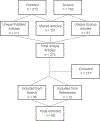Clostridioides difficile ribotype 106: A systematic review of the antimicrobial susceptibility, genetics, and clinical outcomes of this common worldwide strain
- PMID: 32007682
- PMCID: PMC7153973
- DOI: 10.1016/j.anaerobe.2019.102142
Clostridioides difficile ribotype 106: A systematic review of the antimicrobial susceptibility, genetics, and clinical outcomes of this common worldwide strain
Abstract
Clostridioides difficile typing is invaluable for the investigation of both institution-specific outbreaks as well as national surveillance. While the epidemic ribotype 027 (RT027) has received a significant amount of resources and attention, ribotype 106 (RT106) has become more prevalent throughout the past decade. The purpose of this systematic review was to comprehensively summarize the genetic determinants, antimicrobial susceptibility, epidemiology, and clinical outcomes of infection caused by RT106. A total of 68 articles published between 1999 and 2019 were identified as relevant to this review. Although initially identified in the United Kingdom in 1999, RT106 is now found worldwide and became the most prevalent strain in the United States in 2016. Current data indicate that RT106 harbors the tcdA and tcdB genes, lacks binary toxin genes, and does not contain any deletions in the tcdC gene, which differentiates it from other epidemic strains, including ribotypes 027 and 078. Interestingly, RT106 produces more spores than other strains, including RT027. Overall, RT106 is highly resistant to erythromycin, clindamycin, fluoroquinolones, and third-generation cephalosporins. However, the MIC90 in most studies are one to two fold dilutions below the epidemiologic cut-off values of metronidazole and vancomycin, suggesting both are acceptable treatment options from an in vitro perspective. The few clinical outcomes studies available concluded that RT106 causes less severe disease than RT027, but patients were significantly more likely to experience multiple CDI relapses when infected with a RT106 strain. Specific areas warranting future study include potential survival advantages provided by genetic elements as well as a more robust investigation of clinical outcomes associated with RT106.
Keywords: Anaerobe; Molecular surveillance; Recurrence; Spores; Strain typing.
Copyright © 2019 Elsevier Ltd. All rights reserved.
Conflict of interest statement
Declaration of competing interest All authors report no conflict of interest.
Figures



References
-
- Johnson S and Gerding DN, Clostridium difficile--associated diarrhea. Clin Infect Dis, 1998. 26(5): p. 1027–34; quiz 1035–6. - PubMed
-
- Hall AJ, et al., The roles of Clostridium difficile and norovirus among gastroenteritis-associated deaths in the United States, 1999–2007. Clin Infect Dis, 2012. 55(2): p. 216–23. - PubMed
Publication types
MeSH terms
Substances
Grants and funding
LinkOut - more resources
Full Text Sources
Molecular Biology Databases
Miscellaneous

